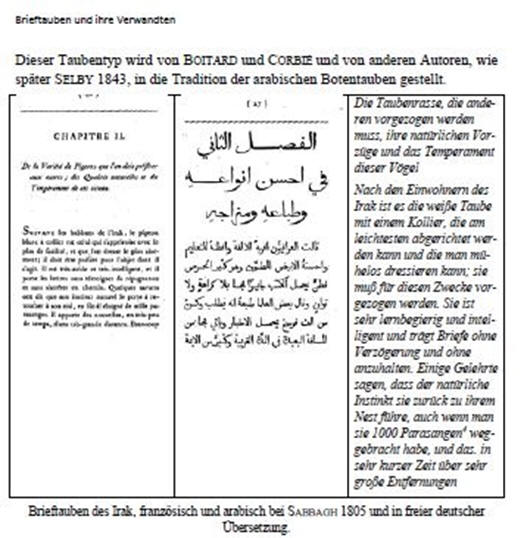|
How high do they fly?
Homing Pigeons and Highflyers.
Flight altitudes of pigeons used to be the subject of discussion,
especially for high-flying pigeons. Jürgen von Ramin had
investigated the question of flight altitude by barometric altitude
measurement. Above 800 m, storked Vienna Tumblers were invisible.
The flight log showed a maximum altitude of 836.3 m for a short
time.

Schwanz- und
Rückenmontage beim AltmeterThree im Artikel von Jürgen von Ramien.
Quelle: Sell, Taubenzucht 2019
The fact that it is possible to fly even higher, albeit out of sight
of the human eye, was shown by more recent records of Racing Homer
pigeons. These were equipped with GPS bands so that route, altitude
and speed could be recorded. It is well known that racers do not
always take the direct route and that the speed measured as an
average (loft measurement/flight time) underestimates the actual
speed. The fact that the detours are greater than usually assumed is
shown by the records of Dietmar Timmer documented in the German
Magazine 'Brieftaube' 28/2022.
 
The
red route was used by ‘Mme20’ and the flock, and the blue direct
route by ‘Uli18’, a hen that also in other flights often took the
direct way. Source: Dietmar Timmer, Die Brieftaube No.. 28/2022
It
also showed that 'swarm behaviour' and the often invoked 'collective
intelligence' of the swarm do not always lead to better results than
individual decisions. ‘Uli18', who had already shown herself to be
headstrong on other flights, chose the direct route on the
documented flight, in contrast to the flock, her way was
significantly shorter. On this flight 'Madame20' flew with the
group. On another occasion, this hen set a record for the measured
flight altitudes during a flight over 507 km. The maximum flight
altitude was 1,666 m, the maximum speed 1,640 m/min.

Check hen 'Madame2O', which participated in all recording flights
and set the current record with an altitude of 1,666m. Source:
Dietmar Timmer, Magazine ‘Die Brieftaube’ no. 28/2022.
From this point of view, Belgian racing pigeons are high-flying
pigeons with a good sense of direction and the ability to fly long
distances. Also, not new. The descent of Belgian homing pigeons from
high-flyers is well documented. Molecular genetic studies on the
genetic proximity of breeds had already shown that racing pigeons
had by far the greatest commonalities among 70 pigeon breeds studied
with Tipplers. These evolved in England from continental
high-flyers. A significant contribution will have been made the 'cumulets'.
This brings Arabic sources closer. For example, according to the
book by Michael Sabbagh published in Paris in 1805, the inhabitants
of Iraq particularly valued white pigeons with a neck ring as
messenger pigeons because they were particularly fast and
intelligent.

Source: Sell, Brieftauben und ihre Verwandten 2015
Such pigeons are depicted by Boitard and Corbié in 1824 as Pigeon
Volant Cou Rouge. They are described as part of a high-flying group
found in Liège and elsewhere. They are predecessors of the Cumulets
in England and other later white high-flyers on the continent.

Pigeon Volant Rouge (1824) and Cumulet (1925). Source: Sell,
Taubenzucht 2019)
The quality characteristics of good messenger pigeons mentioned by
Al Djahiz (776-868-9), such as appropriate neck length, balance of
the different body parts and the smallness of the beak (quoted from
Nefti Bel-Haj Mahmoud 1972, 1981), also fit such pigeons.

Al
Djahiz, Illustration in the ‚Book of Animals’. Source: Sell,
Taubenzucht, Achim 2019
Literature:
Bel-Haj Mahmoud,
Nefti, La La psychologie des animaux chez les Arabes, Paris 1972,
Lille 1981
Sabbagh, Michel, La Colombe Messagere. Plus Rapide Que LÉclair, Plus
Prompte Que la Nue, Traduit de L’Arabe en Francois par A.I.
Silvestre de Sacy, Paris 1805.
Sell, Axel,
Brieftauben und ihre Verwandten, Achim 2014.
Sell, Axel,
Taubenzucht. Möglichkeiten und Grenzen züchterischer Gestaltung,
Achim 2019.
Timmer, Dietmar,
Erkenntnisse durch GPS-Ringe, Die Brieftaube 139 (2022), Nr. 28, S.
4-10.
Von Ramin,
Jürgen, Flughöhen unserer Hochflugtauben, Geflügel-Zeitung 1/2016,
S. 44-47.
|